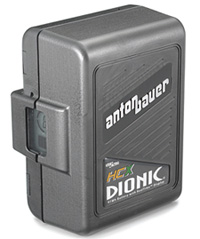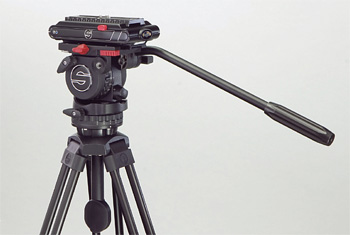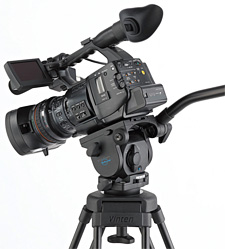Shrinking Cameras Demand Versatile Gear
SEATTLE
The number one piece of gear in a TV news photographer’s professional life is the video camera. So when TV Technology asked camera support, portable light and battery makers what was driving their new products for television news organizations, they pointed to changes in the cameras being used.
Specifically, the word “smaller” came up over and over again. Where there are obvious advantages for a run and gun news photographer to have a smaller, lighter weight camera to carry, there are tradeoffs that can take away some of the capabilities that these news shooters have come to depend on.
MORE POWER TO POWER MORE
A good example of such a tradeoff is in power. In order to build smaller camcorder packages, camera makers have gone to smaller batteries. These may be ample to run a less power-hungry camcorder itself, but what about the portable light, wireless mics and other accessories?
“News photographers were used to these bigger camcorders, which could hold everything, and all of a sudden they’ve got a small camera in their hand,” said Ed Kuhn, vice president of sales at Frezzi in Hawthorne, NJ. “You cannot just put all the stuff on them and go out in the field anymore.”

Anton/Bauer Dionic HC X

Litepanels SolaENG
In response, Frezzi developed the HH-1, which fastens to the smaller camcorder and not only provides a multi-purpose support bar to attach accessories, but also a 65Wh battery to supply power. It sports a hand grip and can be mounted easily onto the tripod.
“The trend toward smaller camcorders leaves the news photographers with very little on-camera power to handle accessories,” said Vickii Chaffee, general manager - sales and marketing for IDX System Technology, Inc. in Torrance, Calif. “So we have come out with a dual D-tap V-mounting plate that allows you to use the bigger boy batteries, and not only get more hours of run-time from the camera itself, but also to run on-board lights and other pieces of gear.”
IDX’s mounting plate handles voltage conversion to the proper power for the camcorder, and has a pair of taps to plug in accessories. Any of IDX’s V-mount batteries, or those of other manufacturers, can be snapped into the mount.
Paul Dudeck, director of product specialist group for the Americas for Anton/Bauer in Shelton, Conn., pointed out that the need for large batteries is still there for news and other videographers going out on extended assignments. “Where high capacity and weight are concerns, we’ve developed our new Dionic HCX. At 120Wh, you get almost all the power of our Hytron 140 at half the weight.”
Key to bringing this extra power was Anton/Bauer’s collaboration with battery cell maker Sanyo to gain approval for including extra lithium ion cells safely in the DIONIC HCX pack. The new battery provides a fuel gauge to allow photographers to monitor battery usage.
LIGHTING THE WAY
New camera technology has not only allowed manufacturers to make camcorders smaller, but also more sensitive to light, which is changing the business of lighting.
“Because we're in an era where cameras are getting so good in low light that you can walk into a room and not have to fully light the space, you can get your basic exposure with the ambient light,” said Duane Sherwood, director of communications at Lowel Light in Hauppage, NY. “Then you can just add a little frontal fill for cosmetic reasons, to create a little depth, a little bit of contrast between the person and the background.”
Relying on ambient light can mean working with unpredictable color temperatures, with daylight, fluorescent and tungsten sources. “So we developed the Lowel Blender, a compact and bright LED fixture, powered off AC or various camcorder batteries, that has two sets, twin sets of LEDs, one daylight, one tungsten. Each set of LEDs has its own rotary dimmer on the back, so you can go into a room, set your camera up, turn on your light, and then just dial in the right mix of daylight and tungsten.”
Frezzi has long offered its Mini-Fill portable lighting fixture with tungsten and HMI modules, and has now added LED capability to the fixture. “For people who want LED, they simply change the bulb and they’ve got technology that’s dimmable,” said Kuhn. “And if they want tungsten, they’ve got a tungsten lamp. That’s what makes the mini-fill one of the best choices out there, because instead of being just one type of light, it’s futureproof. As technology changes, the mini-fill is just a bulb change away from the latest technology.”
Anton/Bauer’s venerable UltraLight on-camera fixture has a removable head module which now has a new light option. “You can literally change from a tungsten light to an LED, to an HMI, within 3 seconds each, just by pulling the head module off and replacing it,” said Anton/Bauer’s Dudeck, who adds that sister company Litepanels developed a special LED light module for A/B.

Sachtler FSB2

Vinten Vision Blue
IDX’s lighting solution for ENG photographers is the IDX X5-Lite, according to Chaffee. “It provides a lot of light from 50 Watts of power, with excellent color temperature, and it operates with minimal heat,” she said. “The X5-Lite has a built-in dimmer to provide adjustment from 100 percent to zero, and is flicker and noise free.” A one-touch hot shoe allows the X5-Lite to be easily and quickly connected to a wide range of cameras via slide-shoe or thread mount.”
Not only are the news photogs’ cameras getting smaller, but they’re all high-definition, which requires special attention to lighting. “All that detail, all that excruciating detail, every line, every pore, every shadow, every mark on the face, comes through on HD,” said Scott Stuekle, sales and public relations manager at Kino Flo, in Burbank, Calif. His company has a light, originally developed for the motion picture industry, that’s finding its way into news photographer’s light kits to soften the look of HD on faces.
“It's a soft ring light, called a Kamio,” he said, “and especially if they’re shooting the red carpet or an interview on the side of a basketball court, and they need to get a soft, flattering light on the interviewee, they use the ring light that attaches to the lens of their camera, and it's just a soft daylight or tungsten source.”
Fast moving news shooters still find themselves needing to project light across larger distances, to light a live shot or indoor setup. One of the best type fixture to accomplish this has long been a Fresnel lensed light fixture. “News crews have always wanted the performance of a Fresnel fixture for mounting on-camera or on a small light stand, but prior to Litepanels’ LED-based SolaENG Fresnel fixture, their choices would have been too heavy and too power hungry,” said Pat Grosswendt, co-founder of Litepanels, in Van Nuys, Calif.
Litepanels provides the SolaENG, which weighs in at one-third the weight of traditional Fresnels, uses a fraction of the power, and delivers a projected beam of HD-friendly LED light.”
As much as you think of a news photographer chasing breaking news stories, a good deal of his workaday routine is going to be head and shoulder shot interviews. “There's still something to be said for a point source fixture that can give you some punch, and also the ability to be shaped, as opposed to just a spotty, several source mix with multiple shadows,” said Ryan Smith, general manager at K5600 in N. Hollywood, Calif.
For adding a quality, modeling look to interview subjects, K5600 provides its Joker News 200 and Joker News 400 daylight balance fixtures, which can quickly convert from a focusable light fixture to an omnidirectional source.
CAMERA SUPPORT
Again, the trend toward smaller camcorders is shaping the camera support product offerings. One the one hand, they need to provide the smooth pan and tilt capabilities that heavier camera payloads yield by their very mass alone. On the other hand, the fluid heads must have a broad enough counterbalance range to handle additional accessories such as teleprompters, wireless mics and microwave transmitters.
“More and more crews are going over to the new generation of smaller, lighter HD Camcorders,” said Peter Harman, product manager for Vinten in Valley College, NY. While these camcorders have great imaging ability, “they’re often seen fixed to low end tripod systems, and when you ask the crews ‘how’s the kit?’ many will say, ‘the camcorder’s great while it’s still, but the tripod sucks. I just can’t get the quality of move that I need,’” Harman said.

OConnor 1030HDS

Frezzi's Hand Held Professional Camcorder Support Lighting Kit for ENG and videography
Vinten’s solution is its Vision Blue line. “We applied some smart re-engineering to suit a lighter payload,” said Harman, “applied a fresh new look and introduced a revolutionary new tripod system that offers all the professional features and performance you would expect from the larger Vision systems, at a price that’s right for the majority of professional videographers that demand the best from their kit.”
Vinten sister company Sachtler has attacked the ENG videographer’s challenges through a wide range of camera support products. “We can provide the best solution for news photographers no matter what the camera format, or corresponding payload of the camera system,” said Jim Davis, Western U.S. manager for Camera Dynamics Inc., which markets Sachtler in the United States. “The challenge then is to make a smaller tripod and fluid head with the same quality people expect from Sachtler, and at a reasonable price.”
Payload range of our Sachtler’s FSB heads extends down to the FSB 2, designed for cameras weighing from zero to 4.4 pounds, yet provides the same friction-free operation and finely-tuned counterbalance as heavier-duty heads in the FSB line.
Wayne Schulman national sales and product manager for video for Manfrotto, said DSLR-using print photographers pose a special need when it comes to camera support. “Most do not want to give up their style and method of photography to accommodate for video,” he said. “Rigs and tripods slow down their ability to move quickly and get the shots they are looking for.” What they need is some way of steadying the DSLR camera for an occasional video shot of an interview or other static scene.
Schulman suggests either Manfrotto’s 562B-1 or 561BHDV-1 fluid monopod. “It allows the photographer to use his/her camera to get good pictures in their traditional style, the main aspect of their job, but to then be able to quickly set up for a video segment be it a short interview, podium news conference or a walk down the courthouse steps. They can also raise the camera above the heads of onlookers or above or in-between video cameras stationed in premium position on tripods.”
For all the emphasis on light weight camcorder use, there’s still a case to be made for heavier duty tripods and head. “If you’re trying to capture long telephoto shots, you need a rock solid fluid head,” said Ali Ahmadi, marketing manager for OConnor in Burbank, Calif. “The OConnor 1030HDS incorporates OConnor’s continuous sinusoidal counterbalance, it has the famous OConnor drag.” And it handles a payload up to 40 pounds, which also will support accessories like teleprompters and wireless mics with pounds to spare.
The professional video industry's #1 source for news, trends and product and tech information. Sign up below.
